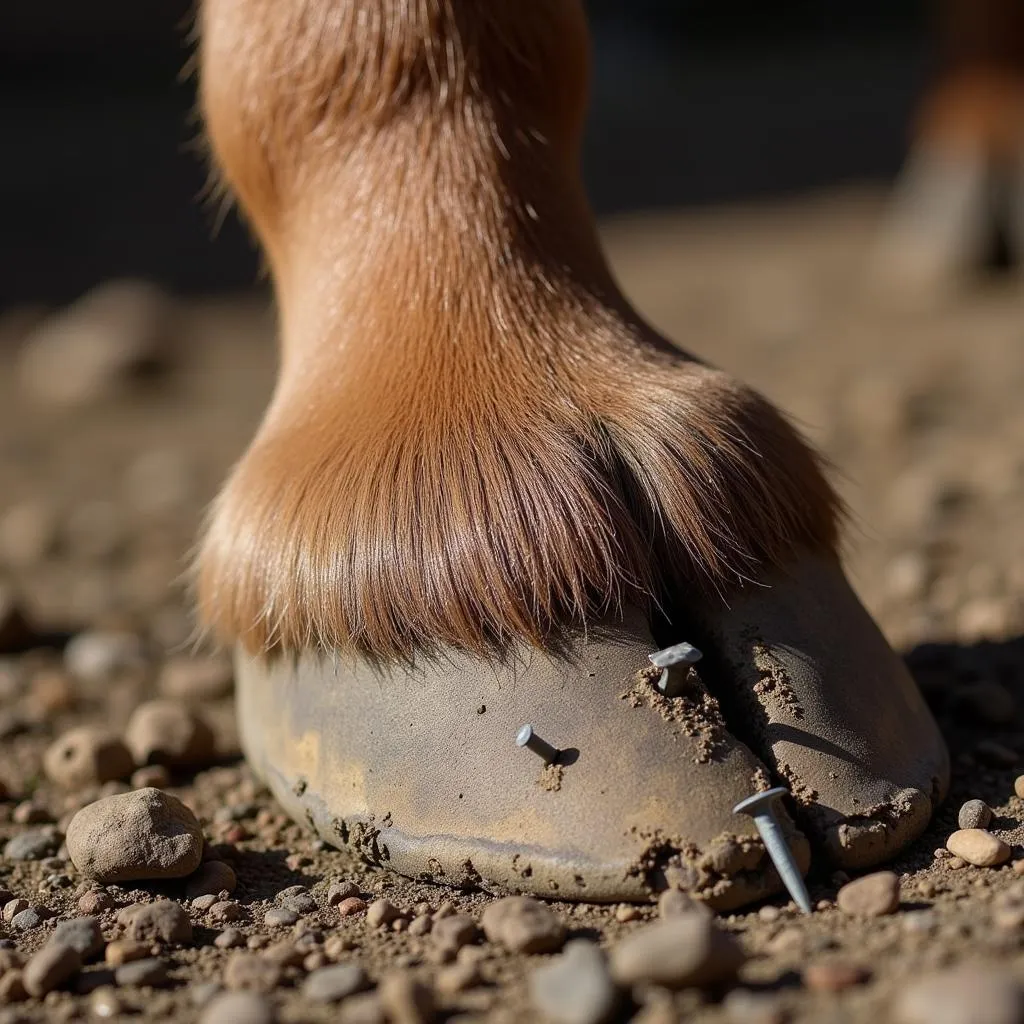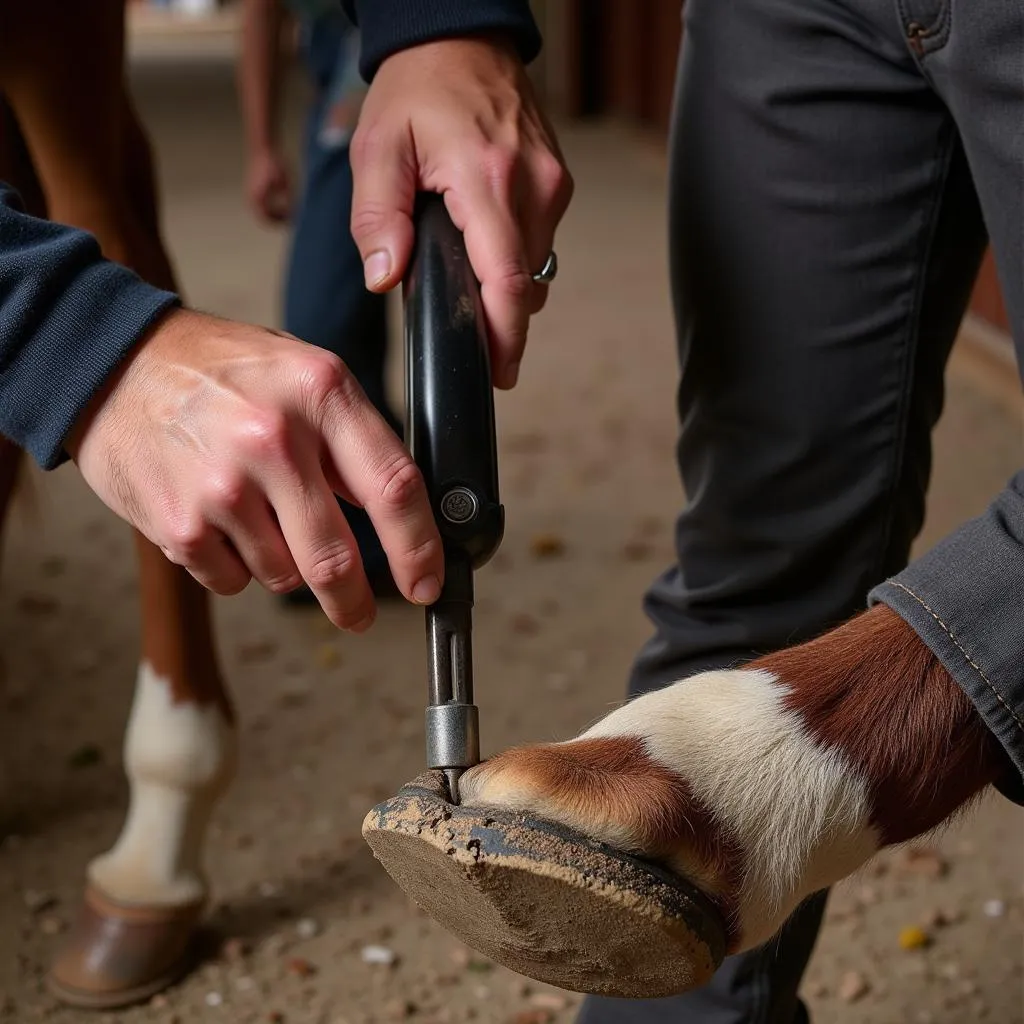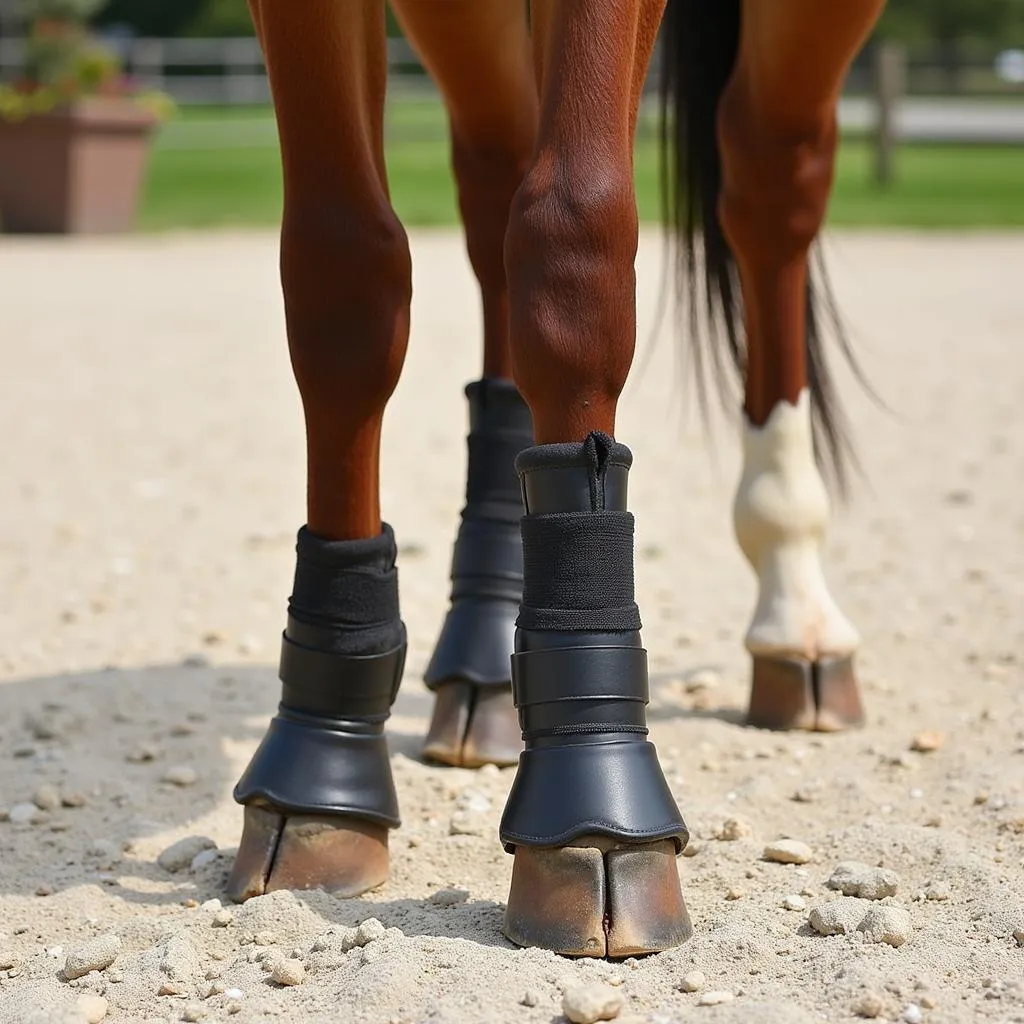Losing a shoe is a common occurrence for horses, especially those who are ridden regularly or spend a lot of time on varied terrain. While not usually a cause for panic, a lost shoe can lead to discomfort, lameness, and even infection if not addressed promptly and correctly. This guide will provide you with all the information you need to handle a lost shoe situation, understand the potential risks, and take preventative measures to minimize future occurrences.
Why Do Horses Lose Shoes?
There are numerous reasons why a horse might lose a shoe, ranging from environmental factors to improper shoeing techniques. Some common culprits include:
- Pulling a shoe off: Horses can accidentally step on and pull off their own shoes, especially during activities like jumping, playing, or navigating uneven ground.
- Weak or worn-out shoes: Over time, horseshoes naturally wear down and become more susceptible to coming loose.
- Improper shoeing: If a shoe is poorly fitted, nailed on incorrectly, or the wrong type for the horse’s hoof and activity level, it’s more likely to come off prematurely.
- Wet conditions: Excessive moisture can soften hooves and weaken the bond between the shoe and hoof wall, increasing the risk of shoe loss.
- Foreign objects: Stones, sticks, or other debris lodged in the shoe can create pressure points and cause it to loosen or detach.
Recognizing the Signs of a Lost Shoe
Early detection of a lost shoe is crucial to prevent further complications. Look out for these telltale signs:
- Visual inspection: Regularly check your horse’s hooves, especially after riding or turnout. A missing shoe will be visually apparent.
- Lameness or reluctance to move: If your horse suddenly becomes lame or hesitant to put weight on a particular foot, a lost shoe is a likely culprit.
- Unusual gait or head bobbing: An altered gait, such as a shortened stride or head bobbing, can indicate discomfort and potentially a lost shoe.
- Finding a shoe: While not always an indicator of a problem, finding a lone horseshoe in your pasture or arena usually means one less is on your horse’s feet.
Immediate Steps After Your Horse Loses a Shoe
Discovering your horse has lost a shoe can be unsettling, but swift and calm action is key. Follow these steps to ensure your equine companion’s well-being:
- Secure your horse: Before inspecting the hoof, safely restrain your horse using a halter and lead rope to prevent further injury.
- Assess the situation: Carefully examine the hoof for any signs of damage, such as cuts, punctures, or bruising. If you notice significant bleeding or lameness, contact your veterinarian immediately.
- Clean the hoof: Use a hoof pick to remove any dirt, debris, or foreign objects lodged in the hoof. Be gentle, especially around the sensitive areas.
- Protect the hoof: If possible, cover the exposed hoof with a hoof boot or a sturdy bandage to minimize the risk of further damage or infection until a farrier can re-shoe the horse.
- Contact your farrier: Schedule an appointment with your farrier as soon as possible to replace the lost shoe. Be sure to inform them of the situation and any observations you’ve made.
The Risks of Leaving a Horse Without a Shoe
While a lost shoe might seem like a minor inconvenience, it’s essential to understand the potential consequences of leaving it unaddressed:
- Hoof damage: Horseshoes provide essential protection for hooves. Without a shoe, the hoof wall becomes vulnerable to chipping, cracking, and wear, especially on hard or abrasive surfaces.
- Lameness: Walking on an unshod hoof can cause discomfort, pain, and lameness, limiting the horse’s mobility and potentially leading to more severe musculoskeletal issues.
- Infection: The exposed hoof is susceptible to bacterial and fungal infections, especially if there are any wounds or punctures.
- Uneven hoof growth: Walking without a shoe can alter the horse’s natural gait and weight distribution, leading to uneven hoof wear and potential long-term hoof imbalances.
Preventing Lost Shoes
While some instances are unavoidable, many preventative measures can significantly reduce the likelihood of your horse losing a shoe:
- Regular farrier appointments: Schedule shoeing or trimming appointments with a qualified farrier every 4-8 weeks, depending on your horse’s individual needs and hoof growth rate.
- Choose the right shoes and shoeing techniques: Consult with your farrier to determine the most appropriate type of shoes, materials, and shoeing techniques for your horse’s breed, conformation, and activity level.
- Maintain healthy hooves: Proper hoof care, including regular cleaning, conditioning, and moisture balance, is crucial for strong, healthy hooves that can hold shoes more effectively.
- Inspect hooves frequently: Make it a habit to visually inspect your horse’s hooves daily, particularly after riding or turnout, to detect any loose shoes or potential problems early on.
- Manage turnout conditions: Be mindful of the terrain in your pastures and paddocks, avoiding excessively muddy, rocky, or uneven areas that can increase the risk of shoe loss.
- Consider hoof boots: For horses prone to losing shoes or those ridden on varied terrain, hoof boots can provide additional protection and support during riding or turnout.
 Horse Hoof with a Missing Shoe
Horse Hoof with a Missing Shoe
What to Expect When the Farrier Arrives
When your farrier arrives to address the lost shoe, here’s what you can generally expect:
- Assessment: The farrier will thoroughly examine the hoof, checking for damage, wear, and the condition of the remaining shoes.
- Preparation: They will clean the hoof and trim any overgrown hoof wall to prepare for the new shoe.
- Fitting the shoe: The farrier will select a suitable shoe size and shape, and may need to heat and shape the shoe to fit the hoof perfectly.
- Nailing and finishing: Using specialized nails, they will carefully attach the new shoe to the hoof wall, ensuring a secure and comfortable fit.
- Final check: The farrier will have the horse walk to observe their gait and ensure the new shoe doesn’t interfere with their movement.
When to Consult a Veterinarian
While a lost shoe is typically a farrier’s domain, certain situations warrant veterinary attention:
- Severe lameness or pain: If your horse exhibits significant lameness, refuses to bear weight on the affected leg, or shows signs of extreme pain, immediate veterinary care is necessary.
- Visible hoof damage: Deep cracks, punctures, avulsions (torn hoof wall), or significant bleeding from the hoof require prompt veterinary intervention.
- Signs of infection: Swelling, heat, redness, pus discharge, or a foul odor emanating from the hoof indicate a potential infection that needs veterinary treatment.
- Concerns about underlying conditions: If your horse repeatedly loses shoes despite proper farrier care, consult your veterinarian to rule out underlying hoof or musculoskeletal issues.
 Farrier Examining a Horse Hoof
Farrier Examining a Horse Hoof
Conclusion: Keep Calm and Call Your Farrier
A lost shoe is a common equine occurrence that, while initially disconcerting, can usually be resolved quickly and effectively with the right approach. By understanding the causes, recognizing the signs, and taking prompt action, you can ensure your horse’s well-being and minimize the risk of further complications. Remember, regular farrier care, diligent hoof management, and a watchful eye are your best allies in preventing lost shoes and keeping your equine partner sound and happy.
FAQs about Horses Losing Shoes
Q: How much does it cost to replace a lost shoe?
A: The cost of replacing a lost shoe can vary depending on your location, the farrier’s fees, and whether additional services like trimming or hoof repair are required. Generally, expect to pay a fee comparable to a regular shoeing appointment.
Q: Can I ride my horse with a missing shoe?
A: It’s generally not recommended to ride a horse with a lost shoe, especially on hard or uneven terrain. Riding without a shoe can exacerbate hoof damage, increase the risk of lameness, and potentially lead to further complications.
Q: Can I put a temporary shoe on my horse myself?
A: Attempting to apply a horseshoe or any type of temporary shoe yourself is strongly discouraged unless you have proper farrier training and experience. Improper shoeing can cause significant pain, injury, and long-term hoof damage.
Q: What are some good hoof supplements for stronger hooves?
A: Consult with your veterinarian or farrier for recommendations on hoof supplements containing ingredients like biotin, methionine, zinc, and copper, which can support hoof health and growth.
Q: My horse keeps losing shoes. What could be the reason?
A: Chronic shoe loss can indicate various factors, including poor hoof conformation, improper shoeing techniques, underlying health conditions, or nutritional deficiencies. Consult with your farrier and veterinarian to determine the underlying cause and develop a management plan.
 Horse Wearing a Hoof Boot
Horse Wearing a Hoof Boot
Need further assistance? Contact Justus Horses USA at Phone Number: 0772127271, Email: [email protected] or visit us at QGM2+WX2, Vị Trung, Vị Thuỷ, Hậu Giang, Việt Nam. Our dedicated team is available 24/7 to address your concerns and provide expert guidance.
Explore our website for more insightful articles and resources on equine health, hoof care, and horse management.